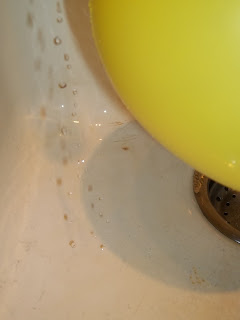In my first attempt to study
static electricity, I will test it using a balloon and a Cheerio. My hypothesis
is that the balloon will essentially have no effect on the Cheerio. I say this
because I doubt that the cereal is charged, making it neutral. Wouldn’t this
mean that regardless of the charge of the balloon, the Cheerio should remain
unaffected since it is neutral, therefore not being attracted or repelled by a
positive or negative charge? Let’s investigate this confusing conundrum!
 I will charge the balloon
with my hair and bring it near the Cheerio to see if the charged balloon
effects it.
I will charge the balloon
with my hair and bring it near the Cheerio to see if the charged balloon
effects it.
Materials:
- a
balloon or a bright pink comb
- a
Cheerio (I have 2 just in case!)
- some
thread
- tape
1. Blow up the balloon.
2. Tie the piece of thread to the Cheerio. The thread
will be hanging from the table.
3. Tape the thread and Cheerio to the table, so that it
hangs freely.
4. Rub the balloon vigorously on your hair in order to
charge the balloon. (You may also use a bright pink comb if you wish.)
5. Very slowly, bring the balloon near the hanging
Cheerio. As the balloon approaches the Cheerio, watch what happens to the
Cheerio!
I am shocked! It seems that the hanging Cheerio moves
towards the balloon. But how is this possible?! You see, the balloon becomes
negatively charged when it is rubbed against my hair. Electrons travel from my
hair onto the balloon. This negatively charged balloon attracts the neutral
Cheerio. The balloon attracts the positive components of the Cheerio and thus,
can hold the hanging Cheerio in mid-swing.
















